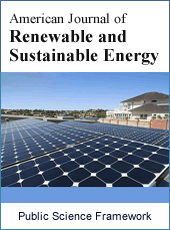American Journal of Renewable and Sustainable Energy
Articles Information
American Journal of Renewable and Sustainable Energy, Vol.4, No.1, Mar. 2018, Pub. Date: Jun. 7, 2018
Investigation of a Solar Thermal Power Generation and Desalination System: An Analytical Study
Pages: 8-23 Views: 2059 Downloads: 500
[01]
Masoud Arabbeiki, Department of Mechanical Engineering, Payame Noor University, Tehran, Iran.
[02]
Mojtaba Bakhshi, Department of Chemical Engineering, Payame Noor University, Tehran, Iran.
Applying new method for a Photovoltaic-Thermal (PV-T) panel system, analytical study was performed for electricity generation as well as desalinated water production. The PV-T panel was designed with a channel under it where seawater would be housed at a constant pressure of 20 kPa and ambient temperature of 15.8°C. The surface of the PV panel was modeled by a high absorption black chrome surface. Irradiation flux on the surface and the heat addition on the saltwater was calculated hourly between 9:00 am and 6:00 pm. The desorbed air then passed through a turbine where it generated electrical power, subsequently condensing into the desalinated water at the outlet. This gave an energy generation range for the turbine of 0.24 W to 1.12 W, while the desalinated water production range was 12.35 kg/ hr.m2 to 52 kg/ hr.m2. System efficiency was found to be between 7.5% and 24.3% and also the desalinated water production efficiency was found to be 40% to 43%.
Desalination, Power Generation, PV-T, Solar, Energy Conversion
[01]
Singh, S., S. Agrawal, A. Tiwari, I. Al-Helal and D. Avasthi, Modeling and parameter optimization of hybrid single channel photovoltaic thermal module using genetic algorithms. Solar Energy, 2015. 113: p. 78-87.
[02]
Dev, R. and G. Tiwari, Characteristic equation of a hybrid (PV-T) active solar still. Desalination, 2010. 254 (1-3): p. 126-137.
[03]
Kumar, S. and A. Tiwari, Design, fabrication and performance of a hybrid photovoltaic/thermal (PV/T) active solar still. Energy Conversion and Management, 2010. 51 (6): p. 1219-1229.
[04]
Licht, S., S. Ghosh, H. Tributsch and S. Fiechter, High efficiency solar energy water splitting to generate hydrogen fuel: Probing RuS2 enhancement of multiple band electrolysis. Solar energy materials and solar cells, 2002. 70 (4): p. 471-480.
[05]
Wolf, M., Performance analyses of combined heating and photovoltaic power systems for residences. Energy Conversion, 1976. 16 (1-2): p. 79-90.
[06]
Raghuraman, P., Analytical predictions of liquid and air photovoltaic/thermal, flat-plate collector performance. Journal of solar energy engineering, 1981. 103 (4): p. 291-298.
[07]
Coventry, J. S., Performance of a concentrating photovoltaic/thermal solar collector. Solar Energy, 2005. 78 (2): p. 211-222.
[08]
Akbarzadeh, A. and T. Wadowski, Heat pipe-based cooling systems for photovoltaic cells under concentrated solar radiation. Applied Thermal Engineering, 1996. 16 (1): p. 81-87.
[09]
Li, C., Y. Goswami and E. Stefanakos, Solar assisted sea water desalination: A review. Renewable and Sustainable Energy Reviews, 2013. 19: p. 136-163.
[10]
Chow, T. T., A review on photovoltaic/thermal hybrid solar technology. Applied energy, 2010. 87 (2): p. 365-379.
[11]
Chen, X., L. Liu, Y. Y. Peter and S. S. Mao, Increasing solar absorption for photocatalysis with black hydrogenated titanium dioxide nanocrystals. Science, 2011. 331 (6018): p. 746-750.
[12]
Li, C., G. Kosmadakis, D. Manolakos, E. Stefanakos, G. Papadakis and D. Goswami, Performance investigation of concentrating solar collectors coupled with a transcritical organic Rankine cycle for power and seawater desalination co-generation. Desalination, 2013. 318: p. 107-117.
[13]
Mar, H. Y., R. Peterson and P. B. Zimmer, Low cost coatings for flat plate solar collectors. Thin Solid Films, 1976. 39: p. 95-103.
[14]
Zefreh, M. A., Design and CFD Analysis of Airborne Wind Turbine for Boats and Ships. International Journal of Aerospace Sciences, 2016. 4 (1): p. 14-24.
[15]
Duffie, J. A. and W. A. Beckman, Solar engineering of thermal processes. 2013: John Wiley & Sons.
[16]
Bosanac, M., B. Sorensen, K. Ivan, H. Sorensen, N. Bruno and B. Jamal, Photovoltaic/thermal solar collectors and their potential in Denmark. Final Report, EFP Project, www. solenergi. dk/rapporter/pvtpotentialindenmark. pdf, 2003.
[17]
Akhtar, N. and S. Mullick, Computation of glass-cover temperatures and top heat loss coefficient of flat-plate solar collectors with double glazing. Energy, 2007. 32 (7): p. 1067-1074.
[18]
Buchovska, I., O. Liaskovskiy, T. Vlasenko, S. Beringov and F. M. Kiessling, Different nucleation approaches for production of high-performance multi-crystalline silicon ingots and solar cells. Solar Energy Materials and Solar Cells, 2017. 159: p. 128-135.
[19]
Kabelac, S., Exergy of solar radiation. International journal of energy technology and policy, 2005. 3 (1-2): p. 115-122.
[20]
Iqbal, M., An introduction to solar radiation. 2012: Elsevier.
[21]
Çengel, Y. A. and M. A. Boles, Thermodynamics: An Engineering Approach, -PDF. 2008: McGraw-Hill.
[22]
Gude, V. G., N. Nirmalakhandan and S. Deng, Desalination using solar energy: towards sustainability. Energy, 2011. 36 (1): p. 78-85.
[23]
Cooley, H. and N. Ajami, Key issues for seawater desalination in California, in The World’s Water. 2014, Springer. p. 93-121.

ISSN Print: 2381-7437
ISSN Online: 2381-7445
Current Issue:
Vol. 4, Issue 4, December Submit a Manuscript Join Editorial Board Join Reviewer Team
ISSN Online: 2381-7445
Current Issue:
Vol. 4, Issue 4, December Submit a Manuscript Join Editorial Board Join Reviewer Team
| About This Journal |
| All Issues |
| Open Access |
| Indexing |
| Payment Information |
| Author Guidelines |
| Review Process |
| Publication Ethics |
| Editorial Board |
| Peer Reviewers |


